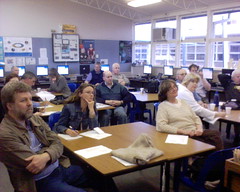I hope Richard doesn't mind me reproducing this post to
seriousgames@listserver.dmill.comI'm not sure I can reply to this without sounding inherently defensive and self-justifying, as I am in academia, but let me try to address at least the concepts of procedural vs. declarative, which have very particular meaning in my field (instructional design). I should preface all this as well by saying that, too often, "academic" is seen as opposed to "real world", with admittedly good
justification in many cases. After all, theory without application is useless, and many academics publish theories that have not been validated or informed by real world practice. To answer your question requires a post of some length (or perhaps this is just an occupational hazard!).
First, regarding the tension between real world and academia, not all
practitioners are theoreticians (different skills sets and interests), nor are all theoreticians practitioners. The problem, in my opinion, lies only in the lack of practitioners who attempt to apply (and thus refine and validate) theory, and theoreticians who attempt to develop theory from practice. If we denegrate either real world or academia, we are ignoring 50% of what is needed to make progress. In order for any field to advance, each must be informed by the other in a constant cycle. If not, we end up with anecdotal evidence from practice that we know worked with one population under one set of circumstances, but with no ability to generalize or extrapolate principles that we can use in multiple domains and circumstances. Conversely, we also end up with theory that soundsgreat but with no practical applications, heuristics, etc.
For me, this is particluarly difficult because I am an instructional designer. Instructional design straddles the academic and "real world" because of its origins and its practices. Instructional design is a part of the same field as human performance technology, which is decidedly rooted in the real world measurement and improvement human performance in the workplace. As instructional designers, we have to recognize that some solutions are training, and some are not (HPT).
In both cases, however, we ALWAYS start with the end goal and work backwards from there. For us, the end goal is ALWAYS rooted in real world practice and performance.
ID arose from the distillation of best practices and theory from education, communications, and psychology. Theoreticians from these fields were assembled by the military to solve a very real, applied problem--how to know that the thousands of soldiers being sent to fight during WWII actually had the competencies they needed to stay alive. As such, all of these academic theoreticians applied what was
know about how humans learn to the practical problem and constraints of keeping soldiers alive while keeping the training in line with the constraints.
This process was further refined by Robert Gagne in 1965, who identified the conditions of learning in which he pointed out that there was a disconnect between instruction (external events) and learning (internal events). He formulated this through thousands of hours of observation of the best practices of teachers and trainers (practical) and the study of human learning theory over the last
thousand years. He pointed out that there were different kinds of learning: intellectual skills (in turn comprised of, from most to least complex, problem-solving, which requires rules, which require concepts, which require discrimination), motor skills, cognitive skills, affect, and verbal information. People who mistook problem solving for memorization of verbal information (still all too common) were not teaching effectively.
This is the same kind of distinction that is implied by declarative vs. procedural. Declarative knowledge is akin to verbal information-- it is things that you can state aloud. This is NOT the same as being able to DEMONSTRATE it, however. Being able to state that subtracting larger numbers from smaller numbers results in a negative number is NOT the same as being able to do it, for instance. Procedural
knowledge is skills that may also include declarative knowledge, but which ultimately is some task or set of behaviors that must be demonstrated and which are sequential and/or hierarchical (printing a document in Microsoft Word, operating a machine, etc.). The analysis of these two kinds of skills is very different, and leads to different objectives, which in turn must be aligned with appropriate
assessments (which by the way, for IDers, are almost always demonstrated in authentic, "real world" ways). Implicit vs. explicit
This kind of theoretical refinement, combined with practical application, has resulted in a systems view of learning and human performance which is very effective precisely because it explicity defines and makes visible what ALL good instruction has done since we first began teaching. By making these things explicit, everyone has the opportunity to use and apply them. Without it, we cans say only that "some teachers/trainers are good, some are not; sure wish we knew how to capture that expertise!"
--
Richard N. Van Eck
Associate Professor, Graduate Director
Instructional Design & Technology
http://idt.und.eduDepartment of Teaching & Learning
Education Room 101
231 Centennial Dr Stop 7189
Grand Forks, ND 58202-7189
Labels: VanEck



